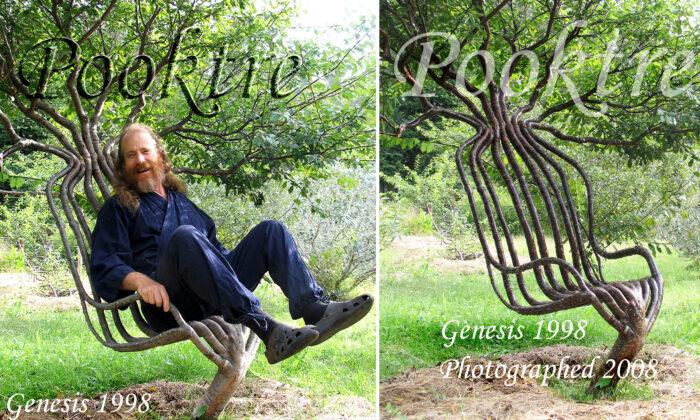Two self-taught artists from Australia have found their creative outlet in crafting furniture and art out of living trees. Through planning and patience, they make art that evolves over time, with the utmost respect for nature.
An incredible “living chair” that took nine years to finish has put the couple on the map.
Peter Cook, 65, and Becky Northey, 51, met in 1995. Both are self-taught artists and have lived in Portugal since 2017 making furniture and art under the creative name Pooktre—a seven-letter name combining Peter’s nickname, “Pook,” the word “tree,” and Peter’s favorite number, seven. The couple said Pooktre was acknowledged as a world leader in tree-shaping art at a world expo in Aichi, Japan, in 2005.
The couple’s flagship artwork, a prunus myrobalan, or wild plum tree, trained into the shape of a chair, was begun in 1998. Today, it’s a beautiful mature tree and a unique, functional piece of furniture in one.
“It took three years to grow into its shape, and another six years before it could be sat on,” the couple told The Epoch Times. “The key reason for this tree taking so long before it could be used as a chair was due to the local conditions; we had no access to town water and had to rely on rainfall.”



“People throughout history have always desired to work with or be immersed in nature. Therefore, the shaped trees can create a strong reaction when people first see them,” the couple said.
‘I wonder...’
Peter, whose first major creative venture was professional jewelry-making in the late 1970s, had the inspiration to try making furniture from trees while walking in nature.“In 1987, Peter had been to one of his favorite spots, a trio of magnificent fig trees growing on big rocks nestled under a cliff face,” Becky said. “As he was walking home from the cliffs behind his cabin, an idea sprouted in his mind: ‘I wonder if I can grow a chair.’ Just like that, he started working on it the very next day.
“Peter took seven cuttings from a willow, and planted them in a U-shape in the area where he directed the cabin’s wastewater.”



Becky, a jewelry and costume designer, and Peter, who is also skilled in wood and stone carving, have since “tinkered” with using trees to create functional art together.
Gradual Shaping
In their first year together, the couple worked on a coffee table and a mirror. Next, they planted bed-ends, candelabras, chairs, a free-form hat stand, a rocking chair, various sizes of mirrors, and “tree people”—Peter’s personal favorite. While inspired by shapes in nature, Peter and Becky claim serendipity plays a huge role in their design process.The couple have refined their process slowly over 28 years spent working together, a gradual approach that is in stark contrast to “instant arborsculpture,” another tree-shaping methodology that bends fully-grown trees into a desired shape, then fixes them in place until new growth is formed.
“[Instant arborsculpture] is like a tree cast, if you will,” the couple said. “Our process is all about gradual shaping. We start by understanding the tree’s lore, produce a concept project, and then create the design wire for the new growth to follow. Then we plant a seed, seedling, or cuttings, and the shaping process begins as the tree grows.”




“Small designs can come to life in a single growing season, but if you want a fancy chair, you'll have to wait a few years,” they said. "To successfully shape trees, it can take anywhere from 15 to 50 actions in the correct order.
“The proof is in the pudding; the hallmarks of successfully shaped trees are even, balanced, and vigorous growth, especially with pieces that are to remain living art.”
In their field of planted trees in Portugal, the couple has access to rich soil and water, and another species of tree, London Plain. With these resources, they can now “grow a chair” in just five years.



Pushing the Boundaries
Earlier known tree-shaping artists include Axel Erlandson, who became famous in the United States for tree-shaping in the 1920s but kept his secrets to himself until his death in the 1960s. The first book about Erlandson’s trees was written in 1995 by Richard Reames, titled “How to Grow a Chair.”The architect Mark Primack helped save Erlandson’s trees from years of neglect after his death, after which a man named Michael Bonfante carried out a large-scale transplant of the trees to Gilroy Gardens in California.
“Some of Axel’s trees still live and thrive there today,” the couple said.


For Peter and Becky, the joy of their craft is in pushing the boundaries of what’s possible, and they work hard to bring their visions to life.
“In the early years we had some major setbacks,” they said. “Nowadays our miss-steps are small and usually are easily corrected without breaking the rhythm of the dance. Was it worth it? We believe so! After all the time passes, whether you shape a tree or not, the beauty of creating with the trees’ lore is that when you step back, out of the dance, the tree continues on and amplifies over time what you have created together.”









